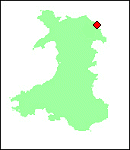
Cymraeg / English

Your Community - Flint
Archaeology and early history of the town
|
|
Introduction
Flint today has very much the aura of a modern town, masking its remarkable and dramatic past as a Roman industrial settlement in the 1st to 3rd centuries, as the first of the new towns and castles created in Wales by King Edward in the later 13th century, and as one of the important industrial towns and ports that emerged at the time of the Industrial Revolution from the beginning of the 18th century. The town’s rich history has been a source of pride for many centuries, shown by the writings of local historians such as Thomas Pennant in the late 18th century up to those writing in local journals and websites in the present day. Flint’s remarkable capacity to reinvent itself, however, has meant that each generation has tended to boldly brush everything aside leaving only a few subtle clues of what went before within the modern townscape.
This study, funded by Cadw, was carried out in 2008 as a contribution to Flintshire County Council’s bid to the Heritage Lottery Fund for a Townscape Heritage Initiative scheme in the town, intended to build on existing regeneration schemes in the town with the intention of physically enhancing the town, attracting visitors and providing a stimulus for further investment and the creation of new jobs.
The present study reviews the history and development of the town since the earliest times and looks at the contribution that archaeology makes to the life of the community today. It focuses on the archaeology and history of the town before its regeneration in the 1960s and attempts to understand how the town came into being and how it has developed topographically and identifies the important factors in its history that make it the place it is today. The study also briefly looks at archaeological and historical opportunities – highlighting some of the features visible in the landscape which tell us about its history, things now buried in the ground which can add to the story, and lastly some of the key themes in the town’s history which are of potential value in helping the past come alive. At the end are listed some of the sources that have proved helpful in this study. The study is accompanied by a number of ‘click-on’ aerial photographs of the town taken by Nigel Jones of CPAT in 2009. The more recent history of the town and surviving buildings are considered in greater length in Flint: Understanding Urban Character (2009), available from Cadw.
The study area includes the modern settlement boundary and areas planned for future industrial and housing. It has also been extended to the north and north-east to include Flint Castle and the adjacent areas of the Dee estuary in the history of the town. Some account has also been taken of farming and industrial history within a slightly broader area around the settlement, generally corresponding the historical extent of the municipal borough.
Privacy and cookies


